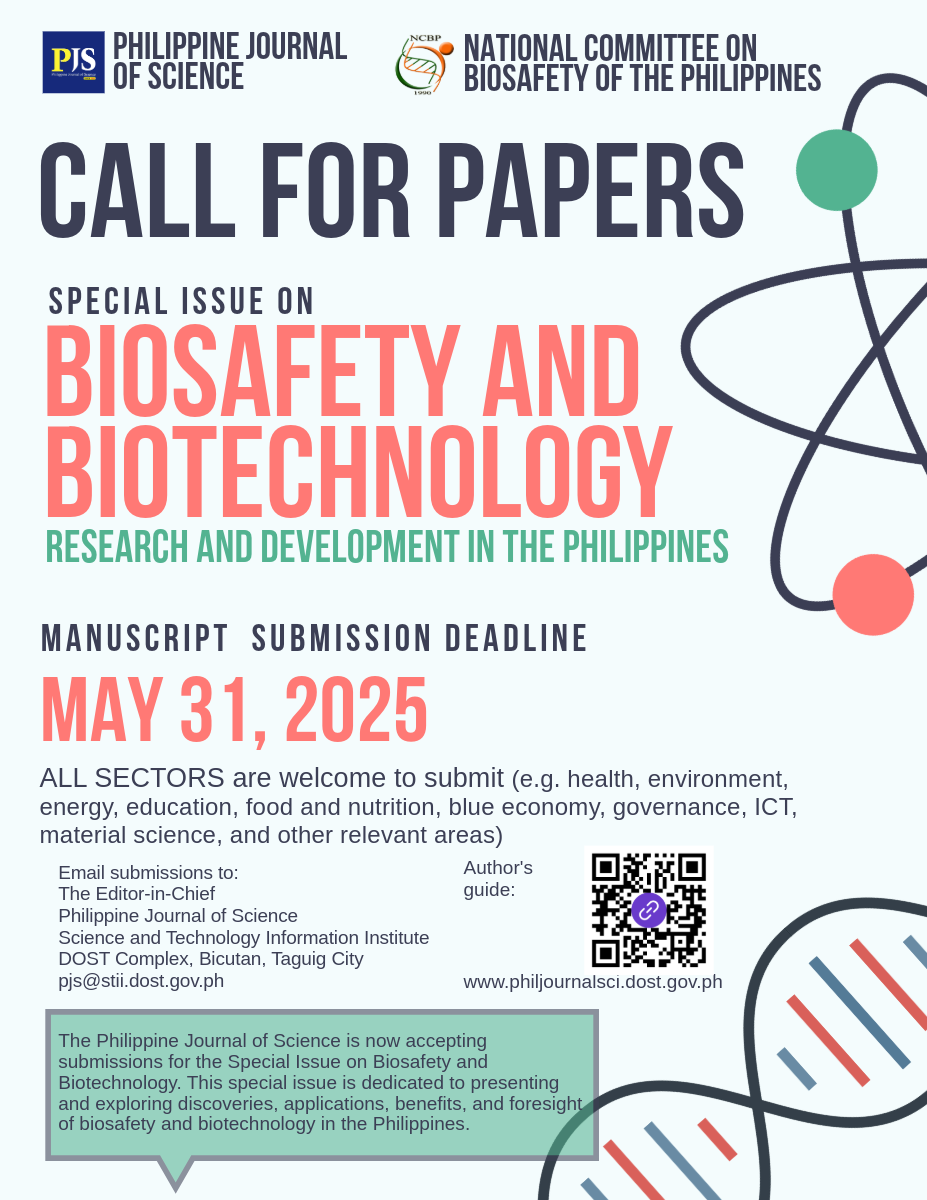Community Structure of Phytoperiphyton in “Lab-lab” (Algal Mat) in Brackishwater Ponds in Relation to Water Depth
Norma R. Fortes1 and Lily Anne G. Piñosa2
1Institute of Aquaculture, College of Fisheries and Ocean Sciences,
University of the Philippines Visayas, Miag-ao, Iloilo
2Brackishwater Aquaculture Center, Institute of Aquaculture, College of Fisheries and Ocean Sciences, University of the Philippines Visayas, Leganes, Iloilo
corresponding author: This email address is being protected from spambots. You need JavaScript enabled to view it.
ABSTRACT
The diversity, a univariate measure of both the number of genera present (richness) and their distribution (evenness), of the phytoperiphyton community of a brackishwater pond that received water from a river and the sea was studied during dry and wet seasons. The algal mat (“lab-lab”) was sampled when the pond was filled to depths of 5, 10, 15, and 30 cm during 2 and 7 days of submergence to determine the effect of seasons, depth and submergence on the diversity and relate it to the trophic status of periphyton-based pond and quality of “lab-lab” as fish food. Generic diversity and evenness declined with increased depth and colonization time during the dry season but not during the wet season. Richness was affected by depth which was significantly different (p≤0.05) at 2 days submergence, and highly significant (p≤0.01) at 7 days submergence. The index of diversity was moderate ranging from 1.0 – 3.2 during dry season and 1.2 - 2.2 during wet season. Richness ranged from 0.7 - 1.4 during dry season and 0.7 - 1.0 during wet season. There were low stabilized genera with evenness that ranged from 0.3 - 0.5 during dry season and 0.2 - 0.5 during wet season. A more diverse community prevailed during the dry season than during the wet season due to differences in environmental conditions.
INTRODUCTION
“Lab-lab” is a local name in the Philippines for the algal mat adhering on the pond bottom like a green pasture under water. “Lab-lab” is technically known as periphyton which is a biological complex of minute plants (phytoperiphyton) and animals (zoooperiphyton) attached to submerged surfaces . . . .
REFERENCES
BIGGS BJF, SMITH RA. 2002. Taxonomic of stream benthic algae, effect of flood disturbance and nutrients. Limnol Oceanogr 47: 1175-86.
CASCALLAR L, MASTRANDUONO P, MOSTO P, REINFFELD M, SANTIAGO J, TSOUKALIS C, WALACE S. 2003. Periphytic algae as bioindicators of nitrogen inputs in lakes. J Phycol 39: 7-8.
COLLIER KJ. 2002. Effects of flow regulation and sediment flushing on instream habitat and benthic invertebrates in a New Zealand river influenced by a volcanic eruption. River Research and Applications 18: 213-226.
DE NICOLA DM, EYTO ED, WEMAERE A, IRVINE K. 2004. Using epilithic algal communities to assess trophic status in Irish lakes. J Phycol 3: 481-495.
DOWNING AL, LEIBOLD MA. 2002. Ecosystem consequences of species richness and composition in pond food webs. Nature 416: 837-840.
FORTES NR, PIŇOSA LAG. 2007. Composition of phytobenthos in “lab-lab”, a periphyton-based extensive aquaculture technology for milkfish in brackishwater ponds during dry and wet seasons. J Appl Phycol 19: 657-665.
FRANCE KE, DUFFY JE. 2006. Consumer diversity mediates invasion dynamics at multiple trophic levels. Oikos 113: 515-529.
GOMEZ KA, GOMEZ AA. 1984. Statistical Procedures for Agricultural Research, 2nd ed. New York: John Wiley and Sons. 680p.
HILLEBRAND H, SOMMER U. 2000. Diversity of benthic microalgae in response to colonization time and euthrophication. Aquat Bot 67: 221-236.
KIFFNEY PM, BULL JP. 2000. Factors controlling periphyton accrual during summer in headwater streams of southwestern. J Freshwater Ecol 3: 339-351.
KOMULAYNEN S. 2004. Experience of using phytoperiphyton monitoring in urban watercourses. Oceanological and Hydrobiological Studies 33: 65-75.
LUDWIG JA, REYNOLDS JF. 1988. Statistical ecology: A primer on methods and computing. New York: John Wiley. 337p.
LUTTENTON MR, BAISDEN C. 2006. The relationships among disturbance, substratum size and periphyton community structure. Hydobiologia 561: 111-117.
MARTINEZ MR, CHAKROFF CL, PANTASTICO JF. 1975. Direct phytoplankton counting techniques using the haemacytometer. Philipp Agric Sci 55: 43-50.
NAEEM S, THOMPSON LJ, LAWLER SP, LAWTON JH, WOODFIN RM. 1994. Declining biodiversity can alter the performance of ecosystems. Nature 368: 734-737.
NGEARNPAT N, PEERAPORNPISAL Y. 2007. Application of desmid diversity in assessing the water quality of 12 freshwater resources in Thailand. J Appl Phycol 19: 667-674.
PETERSON CG. 1996. Response of periphyton communities to natural physical disturbance. In: Algal Ecology. Freshwater Benthic Ecosystem. Stevenson RJ, Bothwell ML, Lowe RL, eds. San Diego: Academic Press. p. 375-402.
RIIS T, HAWES I. 2002. Relationships between water level fluctuations and vegetation diversity in shallow water of New Zealand lakes. Aquat Bot 74: 133-148.
SAGER PE, HASLER AD. 1969. Species diversity in lacustrine phytoplankton: the components of the index of diversity from Shannon’s formula. Am Nat 103: 51-59.
SOMMER U. 1999. The impact of herbivore type and grazing pressure on benthic microalgal diversity. Ecol Lett 2: 65-69.
STRICKLAND JDH, PARSONS TR. 1972. A Practical Handbook of Seawater Analysis, 2nd ed. Ottawa Canada: Fisheries Research Board of Canada. 310p.
VADRUCCI MR, VIGNES F, FIOCCA A, BASSET A, SANTARPIA I, CARRADA GC, CABRINI M, UMANI SF. 2003. Space-time patterns of covariation of biodiversity and primary production in phytoplankton guilds of coastal marine environments. Aquatic Conservation: Marine and Freshwater Ecosystems 13: 489-506.
VALIELA I. 1995. Marine Ecological Processes. New York: Springer. 686p.
VICENCIO ZT. 1977. Studies on the food habits of milkfish Chanos chanos (Forsskal) Fish. Res J Philipp 2: 1-18.
WECKSTROEM J, KORHOLA A. 2001. Patterns in the distribution, composition and diversity of diatom assemblage in relation to ecoclimate factors in Artic Lapland. J Biogeography 28(1): 31-45.
WELCH P. 1949. Limnological Methods. New York: Mc Graw Hill. 380p.
WETZEL RG. 1971. Periphyton: Methods of measuring production rates. In: A Manual on Methods of Measuring Primary Production in Aquatic Environments. Vollenweider RA. ed. Edinburg: Blackwell Scientific Publications Oxford. p. 41-133.









